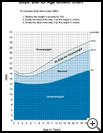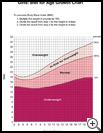
Obesity in Children
Is my child obese?
Your healthcare provider uses your child's height and weight to calculate body mass index (BMI). BMI most accurately shows whether your child is underweight, normal, or overweight. Your child's BMI is compared with that of thousands of children of the same age. This comparison will show what percentile of BMI your child is in. Overweight is greater than the 85% of BMI for your child's age. Obese is usually defined as greater than 95% of BMI for your child's age.
There are so many obese and overweight children that what looks "normal" may be overweight. Pediatric obesity is a health epidemic in the US. Roughly 1 out of 8 children in America are overweight or obese. Almost 1 out of 4 Black and Hispanic children are overweight. It is a very serious health problem.
Why does it matter?
Being obese puts your child at risk for serious health problems. These problems include type 2 diabetes, joint problems, obstructive sleep apnea (a severe snoring disease), severe asthma, hormone problems, liver disease, and high blood pressure.
Being obese can significantly reduce your child's lifespan. Obesity dramatically increases the chances of serious adult health problems such as heart disease, diabetes, cancer, arthritis, hypertension, and stroke.
Is a chubby child a healthy child?
The latest research shows that two-thirds of obese children age 10 or older will become obese adults. Obesity for many children starts by the time they are 3 years of age, and needs to be stopped at that time.
How did this happen?
There are several factors that are thought to increase obesity.
- Increased TV, computer, and video game time
- TV in your child's bedroom is associated with risk of being overweight.
- The number of hours per day that a child spends watching TV or playing video games is directly associated with overweight.
- More TV time is also associated with children having more snacks and sodas.
- Decreased Exercise
- Time spent playing outside is now spent in front of TV.
- Many schools do not provide gym classes for all kids.
- Many communities do not have parks, recreation centers, or swimming pools.
- Fat and Sugar in the Diet
- For many kids, too many calories come from fat and sugar in foods. Fats and sugars are added by many manufacturers for flavor and more may be added by children.
- Drinking soda directly leads to extra calories and increased weight.
- More meals are being eaten outside home, especially fast food meals, which are very high in calories.
- Lack of early recognition by parents, teachers, healthcare providers
- The earlier obesity is recognized, the more likely it can be reversed.
- Ignoring the problem will make it worse.
What can I do to help my child?
You can't control everything your child eats or does, but you can influence health by promoting exercise and a healthier diet. Making healthy lifestyle changes as a family helps everyone. Here are some basic tips to start off with:
- Eliminate sweetened beverages, even juice. They are high in sugar and calories and low on nutrition. It is too easy to drink lots of these to quench thirst, and get an extra 500 or more useless calories per day. This is the single most important change to make.
- Avoid soda, Gatorade sports drinks, sweetened iced tea. Your child should only drink water, seltzer water, skim milk, and occasional diet drinks. If it has high fructose corn syrup or fructose as an ingredient, put it back. This change alone often leads to weight loss.
- Make desserts and candy a treat for special occasions, not a daily ritual. Do not use ice cream, cookies, cake, or candy as a reward for good behavior.
- Limit high calorie dairy foods such as whole milk, cheese, and sour cream.
- Limit carbohydrates like cereal, bread, crackers. A few servings a day are OK, but filling up on these will definitely add extra calories.
- Limit portion sizes to one age appropriate plate. No overloading the plate. For snacks, do not give the whole bag or box, just one small serving. Use good judgment about second helpings. They should also be small in size and include a variety of healthy foods.
- Limit your child's TV and computer time to an absolute maximum of 2 hours total per day. Remove the TV from your child's bedroom. Children who spend more than 2 hours per day in front of TV are more likely to become overweight.
- Help your child to increase daily activities. Enroll in community programs or recreation center if available. Really encourage your child to start going for walks, riding bikes, playing with friends outside, playing sports, or swimming. Burn more calories.
- Support your child. It's important for your child to know that you love and accept him or her at any weight.
- Involve your child in planning and preparing meals. Children may be more willing to eat the dishes they help fix.
If your child's healthcare provider indicates that weight is a concern, your child may have blood tests for pre-diabetes (fasting insulin, fasting glucose), risk for heart disease (cholesterol and blood lipids), and obesity-related liver disease.
What should my child eat?
Emphasize non-processed, whole foods such as lean meat, fish, vegetables, fruits, nuts, whole grains like rice, quinoa, and oats.
Some quick meal ideas:
- Breakfast. Eggs, lowfat yogurt, whole fruit (not juice), oatmeal. Most breakfast cereals are loaded with sugar and should be avoided.
- Lunch. Turkey, tuna, chicken or other lean meat sandwiches, tacos with no sour cream or cheese, salad, fruits, vegetables.
- Dinner. Lean meat (chicken, fish, turkey, pork, beef) with vegetables, salads with lowfat dressings, smaller servings of rice, pasta, noodles.
- Snacks. Fruits, vegetables, nuts (if over 4 years old), peanut, cashew, or almond butter on fruit or lowfat crackers, lowfat yogurt. (Make sure your child does not have a nut allergy before giving for snacks.) Avoid chips, fried snacks as much as possible. Avoid snacks in front of the TV.
- Beverages. Water, seltzer water, unsweetened or diet iced tea, low-calorie powders, occasional diet soda, skim milk.
Make one or two changes at a time and let children adjust. Making big changes in diet or lifestyle is not easy. Sometimes just eliminating sweetened drinks and starting an exercise program will be enough to help your child lose weight.
These are positive changes to help your child to live a healthier life. You may meet with resistance from your child when you take away some of the foods they like. Let them know that you are doing this because you want them to live a long and healthy life.
When should I call my healthcare provider?
You may want to talk with your healthcare provider about meeting with a nutritionist or dietician. These specialists can give you more specific meal planning ideas and diet advice.
Your healthcare provider may also refer you a specialty weight loss clinic if one is available at your hospital.
Last modified: 2011-12-05
Last reviewed: 2011-12-05


